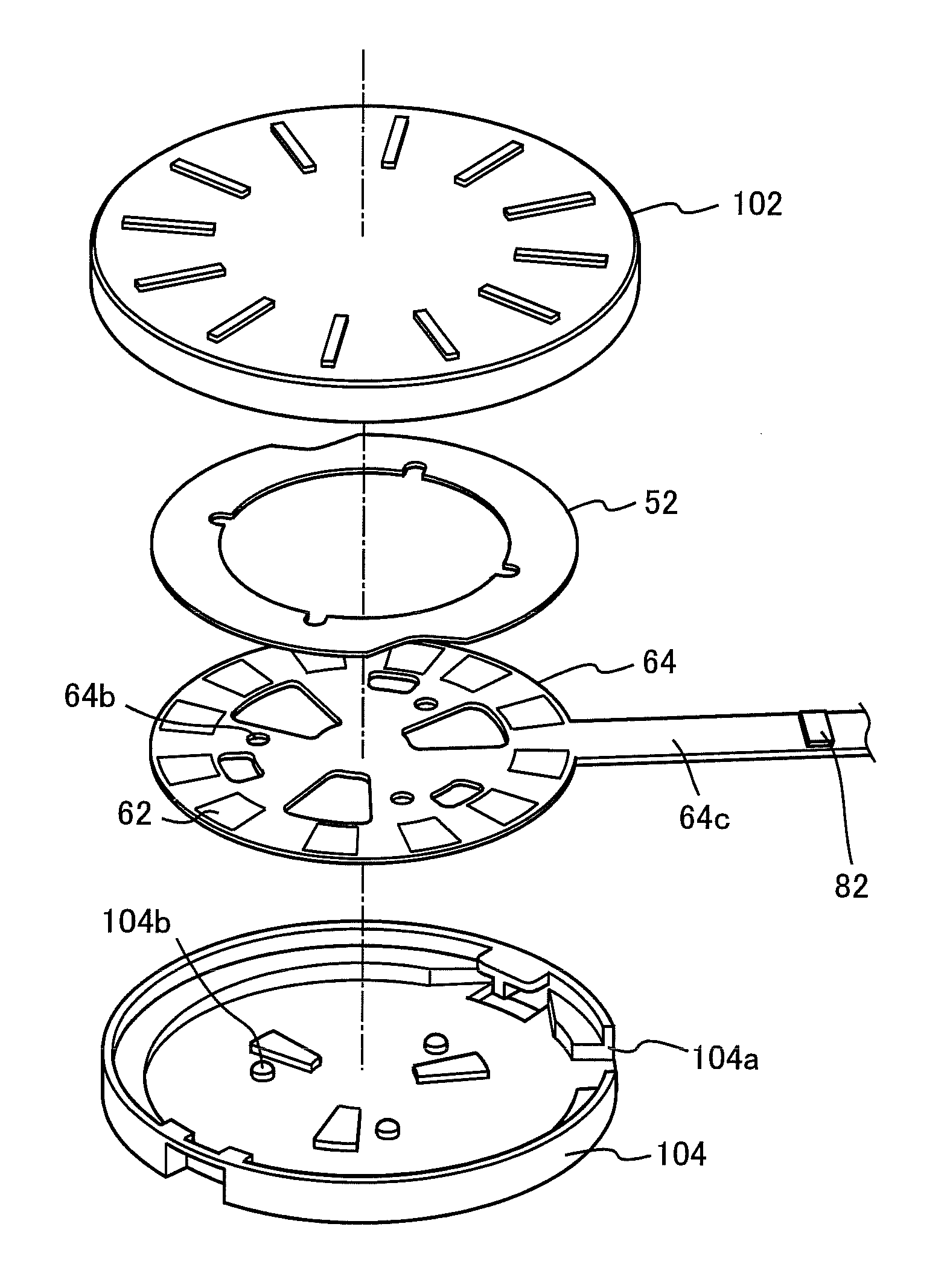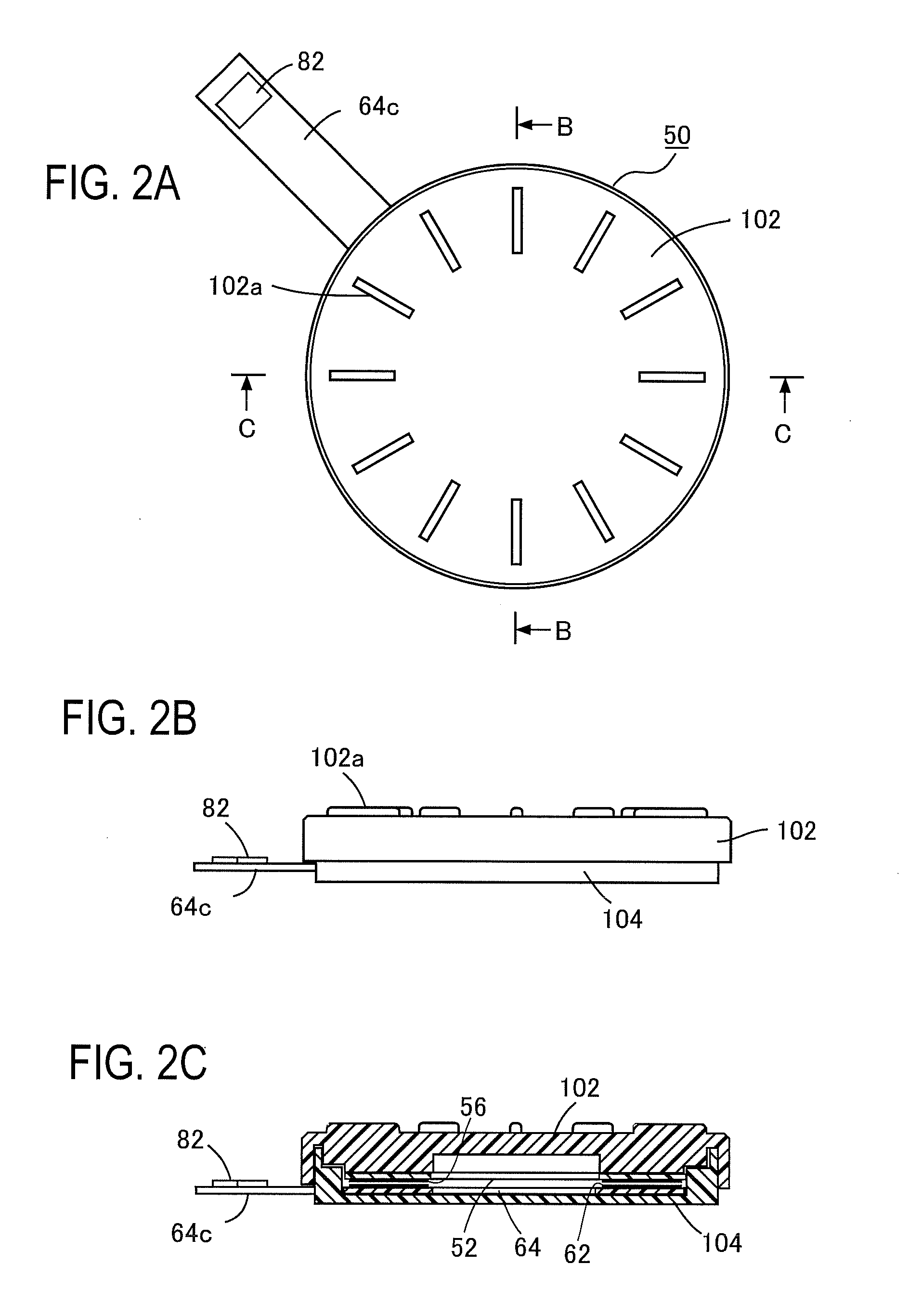Rotary input device and revolution sensor using the same
a technology of input device and revolution sensor, which is applied in the direction of instruments, pulse techniques, coding, etc., can solve the problems of inability to detect the rotation direction of the rotary member, inability to accurately measure the capacitance c, and inability to rotate the rotary member. , to achieve the effect of extreme reduction of capacitance changes
- Summary
- Abstract
- Description
- Claims
- Application Information
AI Technical Summary
Benefits of technology
Problems solved by technology
Method used
Image
Examples
first embodiment
[0107]FIGS. 2A, 2B and 2C are a top plan view of a first embodiment of a rotary input device 50 according to the present invention, its side view, and a sectional view taken along the line C-C, respectively, and FIG. 3 is its exploded perspective view. The rotary input device 50 comprises: an open-topped, shallow cylindrical dish-like casing 104; and a cylindrical lid-like rotary member 102 that is put on the casing 104 from above. The casing 104 and the rotary member 102 are adapted to be able to make sliding contact with each other. On the top surface of the rotary member 102 there are formed radially a plurality of ridges 102a; and the rotary member 102 can easily be turned by pressing its top surface with the ridges formed thereon, for example, with a finger.
[0108]A circular phase electrode holding plate 64 is fixed, as by adhesive, to the bottom of the casing 104. At that time, a plurality of positioning lugs 104b formed on the bottom of the casing 104 and a plurality of positi...
fourth modification
[0155]FIG. 17 illustrates unitary-structured equally-spaced electrodes 56A′ to 56L′ formed by increasing the radial widths of the first equally-spaced electrodes 56A to 56L and the second equally-spaced electrodes 56M to 56X in the Third Modification shown in FIG. 15, so that their opposing circular arcs overlap with each other. The phase electrodes corresponding to the equally-spaced electrodes 56A′ to 56L′ may be those shown in FIG. 16. This modification also produces the same effects as are obtainable with First Embodiment.
fifth modification
[0156]Third Modification, shown in FIGS. 14 and 15, has been described as having a configuration wherein the first equally-spaced electrodes 56A to 56L and the second equally-spaced electrodes 56M to 56X are arranged flush with each other, and the a-phase electrodes 62A to 62F, 62M to 62R and the b-phase electrodes 62G to 62L, 62S to 62X are arranged flush with each other. But these four electrode arrangements may be located all in different planes. The Fifth Modification shown in FIG. 18 is an example of such a configuration.
[0157]The modification depicted in FIG. 18 can be used as a rotary input device such as a mouse wheel. In the rotary input device, as shown in the sectional view shown in FIG. 18, a disc-like rotary member 102 having a rotary shaft 102C is received between casing side walls 104A and 104B, the rotary shaft 102C being rotatably supported by bearing holes 104c made in the interior wall surface of the casing side walls 104A and 104B. The outer periphery of the rota...
PUM
 Login to View More
Login to View More Abstract
Description
Claims
Application Information
 Login to View More
Login to View More - R&D
- Intellectual Property
- Life Sciences
- Materials
- Tech Scout
- Unparalleled Data Quality
- Higher Quality Content
- 60% Fewer Hallucinations
Browse by: Latest US Patents, China's latest patents, Technical Efficacy Thesaurus, Application Domain, Technology Topic, Popular Technical Reports.
© 2025 PatSnap. All rights reserved.Legal|Privacy policy|Modern Slavery Act Transparency Statement|Sitemap|About US| Contact US: help@patsnap.com



